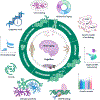Biological sex matters in brain aging
- PMID: 39788086
- PMCID: PMC12210274
- DOI: 10.1016/j.neuron.2024.12.005
Biological sex matters in brain aging
Abstract
Every cell in the body has a biological sex. The expansion of aging research to investigate female- and male-specific biology heralds a major advance for human health. Unraveling and harnessing mechanistic etiologies of sex differences may reveal new diagnostics and therapeutics for the aging brain.
Copyright © 2024 Elsevier Inc. All rights reserved.
Conflict of interest statement
Declaration of interests D.B.D. consulted for Unity Biotechnology and SV Health Investors, serves on the board of the Glenn Foundation for Medical Research, and is an associate editor for JAMA Neurology.
Figures

Similar articles
-
Differently different?: A commentary on the emerging social cognitive neuroscience of female autism.Biol Sex Differ. 2024 Jun 13;15(1):49. doi: 10.1186/s13293-024-00621-3. Biol Sex Differ. 2024. PMID: 38872228 Free PMC article. Review.
-
Neurovascular mechanisms of cognitive aging: Sex-related differences in the average progression of arteriosclerosis, white matter atrophy, and cognitive decline.Neurobiol Dis. 2024 Oct 15;201:106653. doi: 10.1016/j.nbd.2024.106653. Epub 2024 Aug 28. Neurobiol Dis. 2024. PMID: 39214337 Free PMC article.
-
Innovations in Skin and Soft Tissue Aging-A Systematic Literature Review and Market Analysis of Therapeutics and Associated Outcomes.Aesthetic Plast Surg. 2023 Aug;47(4):1609-1622. doi: 10.1007/s00266-023-03322-1. Epub 2023 May 8. Aesthetic Plast Surg. 2023. PMID: 37154849 Free PMC article.
-
Behavioral interventions to reduce risk for sexual transmission of HIV among men who have sex with men.Cochrane Database Syst Rev. 2008 Jul 16;(3):CD001230. doi: 10.1002/14651858.CD001230.pub2. Cochrane Database Syst Rev. 2008. PMID: 18646068
-
[Biological Aging Affects the Rate of Cognitive Decline in Middle-aged and Elderly Populations: A Cohort Study Based on CHARLS].Sichuan Da Xue Xue Bao Yi Xue Ban. 2025 Mar 20;56(2):470-477. doi: 10.12182/20250360203. Sichuan Da Xue Xue Bao Yi Xue Ban. 2025. PMID: 40599287 Free PMC article. Chinese.
Cited by
-
Aging activates escape of the silent X chromosome in the female mouse hippocampus.Sci Adv. 2025 Mar 7;11(10):eads8169. doi: 10.1126/sciadv.ads8169. Epub 2025 Mar 5. Sci Adv. 2025. PMID: 40043106 Free PMC article.
References
-
- Marino F, Wang D, Merrihew GE, MacCoss MJ, and Dubal DB (2024). A second X chromosome improves cognition in aging male and female mice. Preprint at bioRxiv. 10.1101/2024.07.26.605328. - DOI
Publication types
MeSH terms
Grants and funding
- U54 AG076040/AG/NIA NIH HHS/United States
- R01 AG057433/AG/NIA NIH HHS/United States
- R01 AG068325/AG/NIA NIH HHS/United States
- RF1 AG079176/AG/NIA NIH HHS/United States
- R01 AG069750/AG/NIA NIH HHS/United States
- U19 AG056278/AG/NIA NIH HHS/United States
- P01 AG017242/AG/NIA NIH HHS/United States
- DP1 GM119167/GM/NIGMS NIH HHS/United States
- R01 AG061521/AG/NIA NIH HHS/United States
- RF1 AG057341/AG/NIA NIH HHS/United States
- R01 DK127778/DK/NIDDK NIH HHS/United States
- R35 GM142395/GM/NIGMS NIH HHS/United States
- R01 AG076433/AG/NIA NIH HHS/United States
- R01 AG057706/AG/NIA NIH HHS/United States
- RF1 AG068325/AG/NIA NIH HHS/United States
- R01 GM104459/GM/NIGMS NIH HHS/United States
LinkOut - more resources
Full Text Sources
Medical

